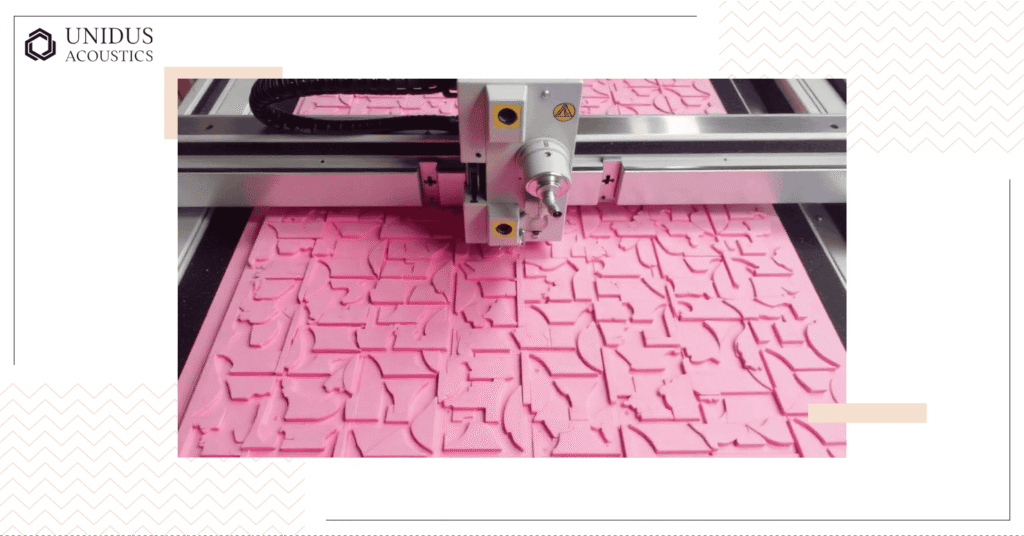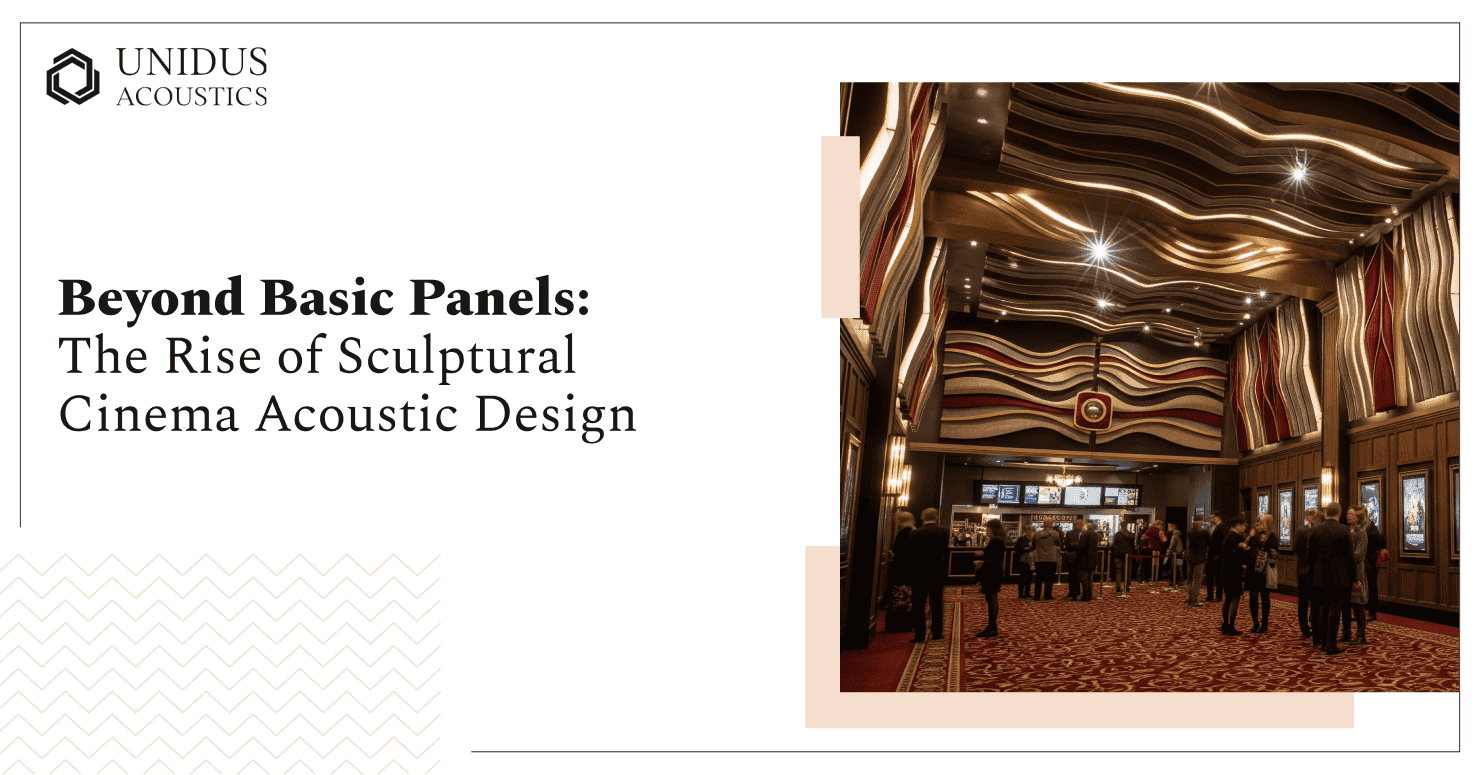Why do some cinemas instantly feel comfy while other places – your living room, a cafe, even a makeshift projector room, despite stunning visuals – leave viewers restless and disconnected from the on-screen action? The answer lies in the cinema acoustic design, and 2025 has already witnessed a massive change in how we integrate sophisticated sound management with top-notch architecture.
Recent research reveals that poor cinema acoustics design can reduce audience satisfaction, directly costing businesses billions annually. This staggering impact is driving cinema owners and architects to prioritise acoustic solutions from day one, not as an afterthought.
At Unidus Acoustics, our 40 years of expertise position us at the forefront of this transformation, where cutting-edge acoustic engineering meets aesthetic integration.
Major Cinema Acoustic Design Trends in 2025 So Far
Here are the major cinema acoustic design trends architects and designers should incorporate in their projects:
1. Ultra-Thin High-Performance Acoustic Solutions
The days of bulky acoustic treatments compromising design vision are ending.
Latest metamaterial technology now delivers exceptional sound absorption in panels as thin as 15mm, compared to traditional solutions requiring 100mm depth for equivalent performance.
These engineered materials manipulate sound waves through precisely calculated geometric structures rather than simple absorption.
For example, a cinema installation can achieve perfect reverberation times using ceiling systems just 25mm thick – a solution that would have been impossible with conventional acoustic panels.
For architects, this breakthrough solves the persistent challenge of acoustic performance versus spatial constraints.
Plus, you can now specify acoustic solutions that enhance rather than compromise your design intent, achieving NRC ratings above 0.95 while ensuring unobstructed sightlines across tiered ceilings.
The key lies in understanding that these solutions require precise acoustic modelling. Each space demands customised engineering to optimise performance for specific frequency ranges and usage patterns. This bespoke approach ensures that your acoustic solutions work as beautifully as they look.
2. Smart Acoustic Environments That Adapt
Think of acoustic solutions that automatically adjust throughout the day to maintain optimal sound conditions. Advanced building systems now monitor film content, audience levels, and scene dynamics to modify acoustic properties in real-time.
Variable acoustic panels with adjustable perforations can transform from high-absorption configurations during busy periods to lower absorption during quiet times.
This technology maintains ideal dialogue clarity during complex action sequences(STI values above 0.75) while maintaining full dynamic range. To note, Speech Transmission Index (STI) is a standardised measure (ranging from 0 to 1) that quantifies how well speech can be understood in a given space or through a communication system.
For design professionals, this represents a fundamental shift from static to dynamic cinema acoustic design. Your spaces can now respond intelligently to changing needs without requiring physical reconfiguration.
3. Next-Generation Materials Redefining Performance

Material science advances are producing acoustic solutions with performance characteristics that seemed impossible just years ago. Aerogel-enhanced panels now achieve NRC ratings exceeding 1.0 while incorporating high SPL handling capabilities (up to 115 dB) essential for cinema sound systems.
Carbon nanotube-reinforced membranes deliver exceptional sound transmission control in barriers thinner than 5mm. These materials challenge traditional assumptions about mass requirements for effective sound blocking, enabling acoustic solutions in applications where space constraints previously made treatment impossible.
Phase-change polymers represent another breakthrough, automatically modifying their acoustic properties based on environmental conditions. During peak occupancy when temperatures rise, these materials increase their absorption capacity to compensate for additional sound generation.
For commercial applications, these materials solve persistent challenges around durability and maintenance. Graphene-enhanced fibres maintain consistent NRC values above 1.0 across the complete frequency spectrum while achieving Class A fire ratings – crucial considerations for public assembly spaces and commercial cinema installations.
4. Biomimetic Design Principles
Nature-inspired acoustic solutions are evolving beyond aesthetic trends to become sophisticated engineering approaches. Honeycomb structures derived from bee architecture achieve optimal strength-to-weight ratios while providing precisely tunable acoustic absorption characteristics.
Shark skin-inspired surface textures reduce HVAC-generated noise while enhancing air movement efficiency – a dual benefit that improves both acoustic comfort and energy performance. These solutions address the common challenge of mechanical noise in modern buildings with extensive HVAC systems.
Owl feather-inspired diffusion patterns create more natural sound distribution without over-damping spaces. This biomimetic approach enhances surround sound distribution while maintaining the acoustic dynamics essential for cinematic immersion.
For architects working on entertainment venues and premium cinema experiences, these solutions provide authentic biophilic benefits beyond visual appeal. The acoustic environment becomes part of the space’s connection to natural principles, supporting occupant wellbeing through both conscious and subconscious responses.
5. Computational Cinema Acoustic Design Integration
Advanced modelling tools now enable real-time acoustic optimisation during the design phase. Sophisticated algorithms analyse sound propagation, reflection patterns for immersive audio formats, and audience response factors simultaneously, eliminating guesswork from acoustic specification.
These tools integrate directly with popular design software, allowing architects to visualise acoustic performance alongside aesthetic elements. Sound ray tracing and reverberation mapping provide immediate feedback on design decisions, enabling acoustic optimisation without compromising architectural vision.
Moreover, predictive modelling can now forecast optimal absorption coefficients for different film genres and audio formats with over 94% accuracy. This capability enables proactive cinema acoustic design rather than reactive problem-solving.
6. Precision Manufacturing and Installation Excellence

The sophistication of contemporary acoustic solutions demands corresponding precision in manufacturing and installation.
CNC machining tolerances under 0.1mm ensure consistent performance across cinema installations meeting THX, Dolby Cinema, and IMAX certification standards. Robotic installation systems achieve positioning accuracy crucial for maintaining calculated acoustic relationships.
Quality assurance protocols include comprehensive in-situ testing using impulse response measurements to validate installed performance against design specifications. This rigorous approach ensures that the designed acoustic performance translates accurately to built environments.
Post-installation optimisation involves micro-adjustments based on measured acoustic parameters, fine-tuning performance to achieve design targets. This precision approach eliminates the performance variations that often compromise acoustic installations.
7. Integrated Acoustic Lighting Solutions
The convergence of acoustic and lighting technologies is creating new possibilities for space design. Acoustic ceiling clouds now incorporate cinema lighting systems that won’t interfere with projection while providing superior sound absorption
These integrated solutions enable cleaner ceiling planes and more sophisticated lighting design. Variable colour temperature capabilities support circadian rhythm considerations while maintaining consistent acoustic performance throughout operational cycles.
Custom-designed acoustic light fixtures can incorporate brand elements, artwork, or architectural details, transforming functional acoustic requirements into distinctive design features. These bespoke solutions ensure that acoustic treatments contribute to rather than detract from overall design narratives.
Takeaway
As we are halfway through 2025, it’s clear that cinema acoustic design is stepping out of the shadows and into the spotlight, becoming a core pillar of modern architecture.
Unidus Acoustics specialises in custom acoustic solutions that seamlessly integrate cutting-edge performance with exceptional design. Our 40 years of expertise, combined with advanced computational design capabilities and precision manufacturing, ensure that your acoustic vision becomes a reality.
We turn complex acoustic challenges into elegant design opportunities, delivering bespoke solutions that create unforgettable cinema experiences that captivate audiences. From initial acoustic consultation through final performance validation, we provide comprehensive support for cinema projects requiring THX, Dolby, or IMAX certification standards.
Contact our cinema acoustic specialists to explore how innovative acoustic solutions can transform your next project because exceptional spaces require acoustic solutions that work as beautifully as they perform.
Discover our complete range of advanced acoustic solutions. You can also schedule a consultation with our design specialists.



